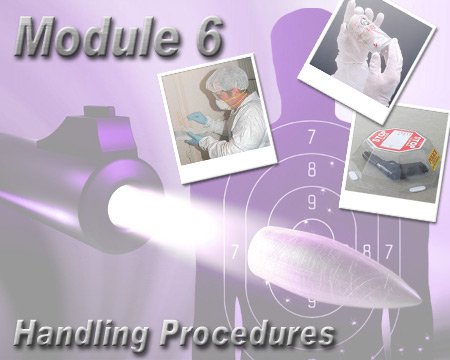Home | Glossary | Resources | Help | Contact Us | Course Map
Archival Notice
This is an archive page that is no longer being updated. It may contain outdated information and links may no longer function as originally intended.
| Author: William J. Tilstone |
| William Tilstone has a B.Sc. and Ph.D. from the University of Glasgow, Scotland. He was a member of the forensic science program faculty at the University of Strathclyde for twelve years before moving to Adelaide, Australia as the director of the State Forensic Science facility. In 1996, Dr. Tilstone was appointed executive director of the newly created National Forensic Science Technology Center (NFSTC). He currently serves the NFSTC as director of training. |
| Author: John H. Dillon, Jr. |
| Jack Dillon earned a B. S. from the United States Naval Academy and an M. Ed. from the University of Virginia. Commissioned in the United States Marine Corps in 1964, he attained the rank of Captain of Marines. Appointed a Special Agent, FBI, in 1970, he investigated diverse criminal violations, including organized crime, bank robberies, extortions, and kidnappings. In 1976 he received orders to the Firearms/Toolmarks Unit of the FBI Laboratory for training as an examiner, where he evaluated evidence and provided on-site field support in domestic cases, as well as abroad. He also designed and taught basic and management level forensic courses at the FBI Academy, Quantico, Virginia, 1982-1988. Jack retired from the FBI as Chief of the Firearms/Toolmarks Unit in 1994, and continues to consult in forensic firearms cases and in training design and delivery. |
Introduction
The handling of physical evidence covers a wide variety of activities from the crime scene to the courtroom. In some jurisdictions, this can extend to the period after trial, including the destruction or disposition of evidence.
This module consists of several topics describing the handling of evidence; the most common types of evidence that may be encountered are described. Specific handling procedures for firearms-related evidence are provided.
The information presented in this module is general and laboratory protocols should be followed whenever handling evidence.
Objectives
On successful completion of this topic the student will be able to do the following:
Physical Evidence
- Define physical evidence and give at least three examples
- Describe at least two important reasons for maintaining the integrity of physical evidence
- Articulate the requirements for maintaining the physical integrity of evidence
Biological Evidence
- Define biological evidence and give at least three examples
- Describe at least two important aspects of the collection of biological evidence
- Define touch DNA evidence
Drug Evidence
- Define drug evidence and describe at least three different case situations in which it can be found
- Describe at least two safety issues encountered in drug cases
Other Evidence Types
- Name at least three types of evidence not covered by the previous categories
Class and Individual Characteristics
- Describe the differences between class and individual characteristics
Associative Evidence
- Define associative evidence and give at least three examples
- Describe four factors that are important in determining the value of associative evidence
Crime Scene
- Explain why crime scene integrity is important to the forensic testing of evidence
- Describe at least four factors that are important in conducting an examination of a crime scene
- Define the crime scene examination approaches
- Explain the procedures employed at a crime scene in packaging firearm or toolmark-related evidence
Evidence in the Laboratory
- Define the elements of a letter of transmittal
- Describe laboratory safety concerns
- Describe the processes of evidence reception at laboratories
- Define chain-of-custody procedures for evidence handling within laboratories
- Describe the benefits of computer-based laboratory information management systems (LIMS)
- Define two methods of case assignment
- Describe options for centralized versus decentralized evidence storage in forensic laboratories
- Define the basic requirements of limited and controlled evidence access
- Describe additional considerations for types of evidence having high intrinsic value
- Define laboratory procedures for handling trace evidence commonly associated with firearm/toolmark-related evidence
AFTE Knowledge and Ability Factors
Evidence
| K 5. | Knowledge of nonfirearms/toolmark types of forensic evidence, such as trace evidence (hairs, fibers, paint, etc.), sereological evidence, etc. |
| K 6. | Knowledge of legal requirements for the preservation of evidence (chain of custody) |
| K 7. | Knowledge of scientific methodologies for the preservation of evidence (packaging and storage) |
| K 9. | Knowledge of which tools, instruments, and containers are most appropriate for the preservation of evidence (packaging and storage) |
| K 10. | Knowledge of the proper storage conditions for evidence collected |
| K 11. | Knowledge of the effects of biological agents (bacteria, molds, insects, animals, etc.) on various types of evidence and ways to prevent their effects |
| K 12. | Knowledge of basic chain-of-custody rules |
| K 13. | Knowledge of the effects that interfering factors (such as substrate, time, activity, temperature, weather, etc.) have upon various types of evidence, and ways to prevent their effects |
| K 14. | Knowledge of how to properly document evidence and analytical results (through notes, sketches, photography, reports, etc.) |
| K 15. | Knowledge of the techniques and procedures used to properly mark evidence (when appropriate) |
| K 20. | Knowledge of various photographic techniques and their application for documenting evidence and analytical results, and for preparing courtroom exhibits |
| K 23. | Knowledge of how each scientific test affects the evidence being examined |
| K 25. | Knowledge of sequential priorities for conducting scientific tests so as not to destroy evidence or contaminate test results |
| K 31. | Knowledge of how to prepare casts and use of casting materials |
| K 46. | Knowledge of how and when to use different probes (such as wood, fiberglass, metal, etc.) for bullet holes |
| K 66. | Knowledge of how and when to use computer systems and work-related computer programs |
| K 83. | Knowledge of the types of trace materials that may be present on firearms |
| K 143. | Knowledge of which professional organizations address firearm and toolmark examiners' concerns |
| A 1. | Ability to recognize the evidence potential of an item |
| A 2. | Ability to recognize and safeguard nonfirearms evidence, such as trace materials |
| A 3. | Ability to recognize bullet impact sites at crime scenes |
| A 7. | Ability to establish and maintain a proper chain of custody |
| A 8. | Ability to maintain a complete inventory of evidence from a particular case |
| A 10. | Ability to evaluate examination requests, while considering the totality of the case |
| A 11. | Ability to adhere to an examination protocol for both firearms and toolmark cases |
| A 12. | Ability to use logic to analyze and identify strengths and weaknesses of different approaches |
| A 89. | Ability to properly document evidence items, examinations, and comparisons |
| A 97. | Ability to recognize the need for additional expertise in certain situations and what can be expected to be gained by their participation |
Crime Scene Investigation
| K 3. | Knowledge of which tools or instruments are most appropriate for the recovery of evidence |
| A 4. | Ability to select the appropriate casting materials (casting of bullets/toolmarks) |
| A 5. | Ability to properly record conditions at a shooting scene or crime scene in general (per lab policy) |
| A 6. | Ability to interpret the value, meaning, and relationship of various items of evidence at crime scenes for the purpose of reconstructing what events occurred (per lab policy) |
| A 67. | Ability to recognize bullet impact sites at shooting scenes |
Additional Online Courses
- What Every First Responding Officer Should Know About DNA Evidence
- Collecting DNA Evidence at Property Crime Scenes
- DNA – A Prosecutor’s Practice Notebook
- Crime Scene and DNA Basics
- Laboratory Safety Programs
- DNA Amplification
- Population Genetics and Statistics
- Non-STR DNA Markers: SNPs, Y-STRs, LCN and mtDNA
- Firearms Examiner Training
- Forensic DNA Education for Law Enforcement Decisionmakers
- What Every Investigator and Evidence Technician Should Know About DNA Evidence
- Principles of Forensic DNA for Officers of the Court
- Law 101: Legal Guide for the Forensic Expert
- Laboratory Orientation and Testing of Body Fluids and Tissues
- DNA Extraction and Quantitation
- STR Data Analysis and Interpretation
- Communication Skills, Report Writing, and Courtroom Testimony
- Español for Law Enforcement
- Amplified DNA Product Separation for Forensic Analysts




